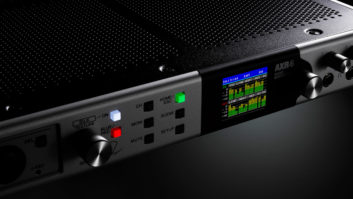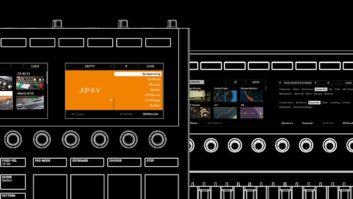
Nuendo 2 has one of the fastest editing interfaces around, but you can get even more satisfaction for your “need for speed” if you learn a few handy shortcuts.
SAVE A COPY
Hard drive space is relatively cheap compared to losing a session, so save a copy early and often. Incremental saves allow you to go back to a previous point in the session’s creation, so you can recover your ideas if you change your mind later. Nuendo’s Save As New Version shortcut increments the project file by one and saves a copy. If your original project was “poodle.npr,” it will now be “poodle-01.npr.” Use CTRL-ALT-S on a PC and CMD-OPT-S on a Mac. QUICK ZOOM
=Put the cursor in the timeline and just drag up or down for instant gratification: horizontal zoom without struggling to land the cursor on that little zoom triangle. If you’ve used the Zoom tool to go to micro-infinity land, you can get back to your original view by hitting CTRL (PC) or CMD (Mac) and clicking with the Zoom tool in a blank area of the project. WHERE DID THE SAMPLE RATE GO?
In the original Nuendo, you could see the sample rate in the Project window, but in Nuendo 2, it’s been moved to Project Setup under the Project menu. Project Setup also contains the project’s start and length, frame rate, display format (timecode, samples, bars+beats, etc.), display offset (down to the subframe for timecode), bar offset, bit depth for record format, record file format and stereo pan law. Always check the project setup when you make a new project — it may save you lots of time later. QUICK AND DIRTY RHYTHM TRACKS
RECORDING WITH EFFECTS
With Nuendo 2, you can set up separate input tracks and assign effects so that the recorded tracks will each have an effect. Leave one track without effects in case you want to add effects later. This is a great technique for creating ultrachunky and superfat guitar tracks. You can turn off the effects to save CPU power after recording the tracks and manage them as a group with folder tracks. FOLDER TRACKS
Folder tracks are created just like other tracks. They’re under the Project menu’s Add Track selection. You can pull any kind of track into a folder track, including another folder track. You can hide folders, solo them and mute them. Folders provide a quick and easy way to manage tracks on a big project, and nested folders are an excellent way to group alternate vocal comps for quick auditioning against instrumental tracks. WATCH THOSE BUFFERS!
If you’re hearing distortion and Nuendo seems to be reacting badly when you add a certain effect, then you may need to increase your buffer size to give the CPU a break. While lowering the buffer size will give you lower latency, during the mix phase, when you need plug-ins, the increased latency trade-off may be worth it. ESCAPING THE 44.1KHZ LIMITATION
I love to edit audio on my G4 Powerbook, but because Nuendo uses the built-in audio controller, I’m limited to 44.1 kHz. Most of my work is done at 48 kHz these days because I work with video and DVD formats for distribution. If you plan to use the Dolby Digital encoder plug to encode tracks for Dolby Digital (AC3) streams that may be used for DVD, then you’ll need to run a 48kHz session. Often, I just need to work with stereo tracks, so I bought an Echo Indigo PC card that has a driver for 48 kHz and 96 kHz, as well as a headphone output. I can edit away while curled up on the couch at home, oblivious to the racket that is swirling around me. One word of warning: Always remember to shut down the card using the pop-up in the Menu bar before you pull it out.
K.K. Proffitt is the co-owner of JamSync, a multichannel surround mixing, mastering, DVD authoring and encoding facility located on Nashville’s Music Row.







